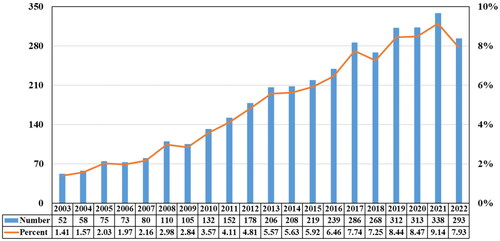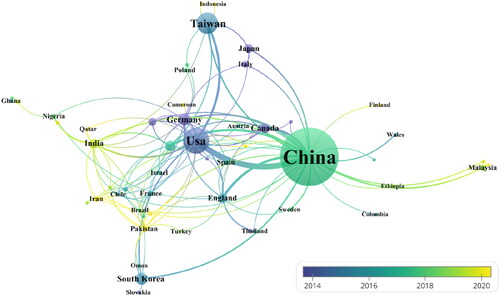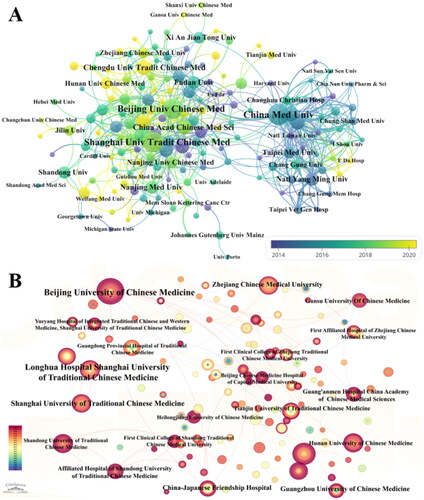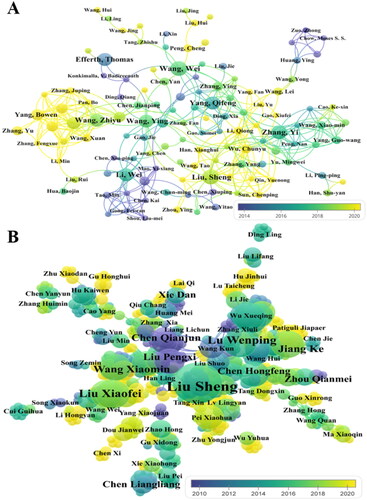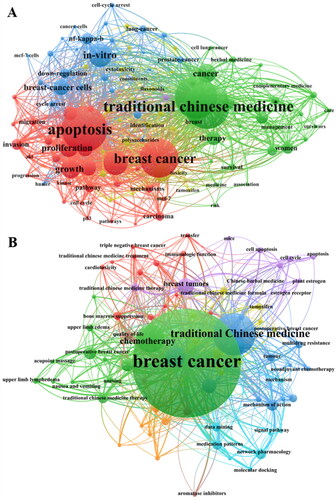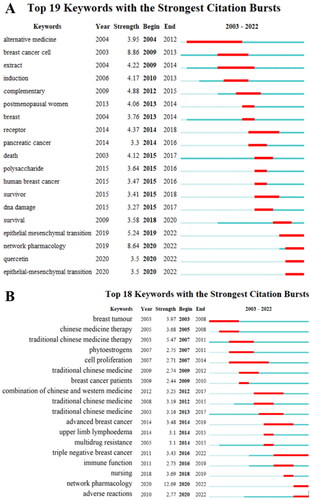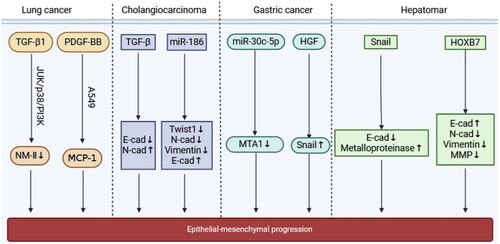Abstract
Context
The use of traditional Chinese medicine (TCM) for breast cancer patients inhibits tumor cell growth and proliferation, alleviates adverse reactions, and inhibits tumor recurrence and metastasis post-surgery. An assessment of its historical efficacy and an examination of the latest research trends are imperative to thoroughly leverage the potential of TCM for breast cancer treatment.
Objective
This study analyzes the published literature on TCM for breast cancer treatment using bibliometric analysis to determine the current state, identify hot spots, and discern trends, providing insight into research in this field.
Methods
TCM-based breast cancer treatment publications between 2003 and 2022 were retrieved from the Web of Science, China National Knowledge Infrastructure, Wanfang, and Duxiu databases. Visual analysis was performed using VOSviewer (V1.6.19) and CiteSpace (V6.3.R1) software. Examined metrics included the annual publication count, literature and journal, national and institutional contributions, author co-occurrence, keyword co-occurrence, keywords timeline, and keywords with citation bursts in this research field.
Results and conclusion
A total of 1080 English publications and 2617 Chinese publications were included in the analysis. China was the leading contributor of publications. High-frequency keywords such as ‘apoptosis’, ‘expression’, ‘in vivo’, ‘chemotherapy’, ‘triple-negative breast cancer’, and ‘lymphedema’ were identified from English and Chinese publications; ‘epithelial mesenchymal transition’ and ‘network pharmacology’ emerged as hotspots. The development of modern science, technology, and in-depth research can result in broader prospects for the research and application of TCM in breast cancer treatment, resulting in more effective solutions for the treatment of breast cancer and other malignant tumors.
Introduction
Breast cancer is one of the most common diseases threatening the lives and health of women. It is the second most common malignancy in women, with the highest number of new cases worldwide, according to the Global Cancer Statistics Report (Lei et al. Citation2021). In 2020, the number of new cases of breast cancer was 2.26 million and surpassed those of lung cancer, resulting in breast cancer becoming the most prevalent cancer worldwide for the first time (Luo et al. Citation2019; Shin et al. Citation2019). Breast cancer is notably prevalent in China. Approximately 420,000 new cases and a 30% mortality rate have been reported in 2020. The incidence rate has shown an overall upward trend in the past decade (Sung et al. Citation2021). Current treatments for breast cancer include operative procedures (Salerno et al. Citation2018), chemotherapy (Tada et al. Citation2023), radiation therapy (Qian et al. Citation2021), and molecular targeted therapy (Greenwalt et al. Citation2020). Though surgery is still the primary and most effective treatment for breast cancer, it causes irreversible damage to the patient’s organs, leading to economic difficulties and psychological stress. Alternative medical treatment methods, such as chemotherapy, endocrine therapy, and molecular targeted therapy could result in drug-induced liver injury (Bae et al. Citation2015), which affects patients’ quality of life and survival. Therefore, there is an urgent need to identify new treatments for breast cancer.
The history of traditional Chinese medicine (TCM) treatment for breast cancer extends to several centuries, showcasing its contribution to the medical field globally. Over several years, the rich experience associated with TCM treatment for breast cancer has resulted in remarkable results because of its unique theory and practices (Chen et al. Citation2023). TCM focuses on symptom relief as well as overall conditioning, adjusting the balance of yin and yang, enhancing the patient’s immunity, and improving resistance to achieve disease treatment. Modern research has shown that TCM not only affects the growth, proliferation, apoptosis, invasion, and migration of tumor cells (Wu et al. Citation2018; Xie et al. Citation2020), but also alleviates adverse reactions in breast cancer patients and inhibits the recurrence and metastasis of tumor cells after surgery to effectively improve the standard of life and survival rates of patients (Zhu et al. Citation2013; Qi et al. Citation2015). The historical effectiveness of TCM in breast cancer treatment warrants further research and widespread promotion. In the context of the rapid development of modern medicine, there is a compelling need to fully explore and utilize the potential of TCM for breast cancer treatment. This exploration can offer additional treatment options and enhance healthcare services, ultimately benefiting breast cancer patients.
Bibliometric technology (Lyu et al. Citation2023; Waks and Kramer Citation2023) utilizes quantitative analysis to reveal publication distribution patterns, the current state, and the evolving landscape of research in a particular field using statistical methods. This approach can facilitate a comprehensive and rapid understanding of the research situation in any field. For example, bibliometric methods have been used to analyze the research status of randomized controlled trials of Chinese herbal medicine published in English from 2010 to 2019 (Hu et al. Citation2021). Similarly, bibliometrics has been used to identify relevant studies on TCM in the treatment of cardiovascular diseases, as included by SCI from 2004 to 2016 (Liu et al. Citation2020). Moreover, the approach has been instrumental in identifying research hotspots and trends in traditional medicine for the Chinese minority during 2021 (Wang et al. Citation2022).
This study systematically collected, identified, and visualized research publications on the TCM-based treatment of breast cancer spanning from 2003 to 2022. Using bibliometrics, the study aimed to comprehensively assess the current distribution and characteristics of these publications, research progress, and research hotspots to serve as a reference for clinical and scientific research on breast cancer treatment.
Materials and methods
Data source and search
The retrieval platforms for this study included the core database of Web of Science, China National Knowledge Infrastructure, Wanfang, and Duxiu, and the time range of January 1, 2003, to December 31, 2022, was covered. In Web of Science, the retrieval formula used was [TS = (breast cancer)] AND [TS = (traditional Chinese medicine)]. The type of publication was set as (journal) OR (review paper) OR (conference proceedings paper) OR (conference abstract) OR (online publication), with the language limited to English. In CNKI, the retrieval formula used was (TS = (traditional Chinese medicine)) AND (TS = (breast cancer)). The type of publication was set as ‘academic journal’. In Wanfang, the retrieval formula was [TS: (traditional Chinese medicine) and TS: (breast cancer)]), and the type of publication was set as academic journal. Finally, in Duxiu, the retrieval formula was [TS = (traditional Chinese medicine) and TS = (breast cancer)], and the type of publication was set as academic journal.
Data analysis
The retrieved articles were exported in the plain text format with full records and references, named ‘download_XXX.txt’, and subsequently imported into the VOSviewer (V1.6.19) and CiteSpace (V6.3.R1) software for further analysis.
VOSviewer software (V1.6.19) was utilized as a tool for constructing and visualizing bibliometric networks (Waltman and Van Eck Citation2013; Perianes-Rodriguez et al. Citation2016; Dora and Kumar Citation2017). This tool has often been used to build collaboration, co-citation, and co-occurrence networks. In this study, this software was applied to analyze the co-occurrence of countries, institutions, and keywords within screened publications.
The CiteSpace software (V6.3.R1), developed by Professor Chen, was used to conduct bibliometric analysis and visualization (Niazi Citation2016; Ding and Yang Citation2022). In this study, it was applied to map keywords with the strongest citation bursts and to analyze research hotspots.
Results
Retrieving results
A total of 1092 relevant English publications were obtained after a search with the retrieval formula. A total of 1090 relevant publications were obtained after filtering document types, and 1080 relevant publications were identified after refining the language to English. Thus, 1080 relevant English publications were included for analysis based on the specified search strategy. From CNKI, a total of 1839 articles were retrieved, and 1031 academic journals were obtained after excluding 668 masters’ or doctoral papers, 85 conference papers, 5 newspapers, and 50 achievements. From the Wanfang database, 1737 results were retrieved, and from the Duxiu database, 483 results were obtained. A total of 634 duplicate articles were filtered, ultimately resulting in 2617 relevant Chinese publications.
Annual number of publications
shows the annual trend of English and Chinese publications related to the TCM-based treatment of breast cancer from 2003 to 2022. The distinct trends were observed over three identified periods: 2003–2007, 2008–2016, and 2017–2022. In the early stage, i.e., between 2003 and 2007, fewer than 100 papers were published annually, indicating that research on the treatment of breast cancer using TCM was in the nascent stage. In the mid-stage, i.e., between 2008 and 2016, the number of annual publications ranged from 110 to 240, surpassing that in the previous period. In the most recent period, i.e., from 2017 to 2022, the number of annual publications increased significantly. Notably, the number of publications peaked at 338 in 2021, accounting for 9.14% of the total number of publications. Conversely, the number of publications plunged to 52 in 2003, accounting for 1.41%.
Literature and Journal
The statistical analysis of journals that publish relevant research literature can identify the most important journals in a field, help researchers select key journals for literature review, and provide valuable reference for researchers to choose appropriate journals for submission and literature research. In terms of English journals, the statistical analysis of 1080 articles revealed that these articles were published in 379 journals. According to , among the 379 journals, Journal of Ethnopharmacology published the highest number of articles (79), accounting for 7.31% of all articles published. In addition, the top 10 journals published 30.83% of all articles. This indicated a relative concentration of preferred journals. Among them, the impact factors of Biomedicine Pharmacotherapy, Frontiers in Pharmacology and Journal of Ethnopharmacology were greater than 5, indicating that most papers on traditional Chinese medicine in the treatment of breast cancer in the database were of high quality.
Figure 2. Top 10 journals for English and Chinese publications.
A: English publications. B: Chinese publications.
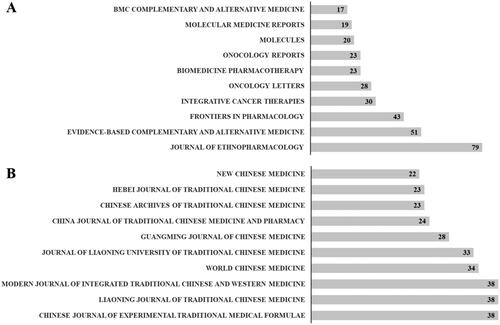
In terms of Chinese journals, the statistical analysis of 2617 articles revealed that these articles were published in 499 journals. shows that the Chinese Journal of Experimental Traditional Medical Formulae, Liaoning Journal of Traditional Chinese Medicine, and Modern Journal of Integrated Traditional Chinese and Western Medicine published the highest number of papers (38), accounting for 1.45% of all publications. In addition, the complex factor of Chinese Journal of Experimental Traditional Medical Formulae, Chinese Archives of Additional Chinese Medicine, Journal of Liaoning University of Traditional Chinese Medicine, and Chinese Archives of Traditional Chinese Medicine were greater than 2.5, indicating that more Chinese papers were also of high quality.
National publications
The statistical analysis of English publications indicated that studies were published by researchers from 52 countries between 2003 and 2022. , shows the collaborative network of countries, where node sizes represent the number of publications in each country; the larger the nodes, the higher the number of publications. Lines among the nodes indicated collaborative relationships; the thicker the lines, the closer the collaboration. The highest number of publications was distributed across Asia, North America, and Europe. China, the United States, and Germany were the top three countries with the highest number of publications, with close collaborations among them. For example, Shanghai Jiao Tong University in China and Vanderbilt University in the USA collaborated to study the prevalence and patterns of complementary and alternative medicine use in Chinese women with breast cancer, and this study specifically explored patient intentions to use herbs, their perceptions of the effectiveness of their use, and the relationship between herbal use and demographic/clinical factors (Cui et al. Citation2004).
The total citation frequency and H-index are the two important indicators that measure the quality of literature. The higher the value of the two, the higher the quality of the literature. In English publications, China (18896 times) received the highest total number of citations, followed by the United States (5535 times), Taiwan (2754 times), Germany (1794 times) and South Korea (757 times). Among the top 10 countries/regions in terms of H index, China (62) ranked first, the United States (42) ranked second, Taiwan (28) ranked third, Germany (18) ranked fourth, and South Korea (17) ranked fifth. The top 10 citation frequency English publications were listed in . Among them, the review titled ‘Traditional Chinese medicine as a cancer treatment: Modern perspectives of ancient but advanced science’ was publicized in 2019 and summarized the molecular mechanisms of chemopreventive and therapeutic activity of TCM. In this paper, the impact of TCM treatment on DNA methylation, histone modification, and the regulation of noncoding RNAs was discussed. The information compiled in this review was served as a solid foundation to formulate hypotheses for future studies on TCM-based cancer therapy (Xiang et al. Citation2019). Furthermore, the review titled ‘The advantages of using traditional Chinese medicine as an adjunctive therapy in the whole course of cancer treatment instead of only terminal stage of cancer’ was publicized in 2015 and summarized the available evidence for using TCM as adjunctive cancer treatment in different stages of cancer lesions. Taken together, TCM has great advantages in terms of inhibiting tumor progression, alleviating surgical complications, improving the sensitivity of chemotherapy and radiotherapy, improving an organism’s immune system function, and lessening the damage caused by surgery, chemo-or radio-therapeutics (Qi et al. Citation2015).
Table 1. Top 10 citation frequency English publications.
Institutional publications
Statistical analysis showed that the top 10 institutions with the highest number of English and Chinese publications were major Chinese medicine universities in China (). In terms of English publications, China Medical University published the highest number of papers (56 articles) on the TCM-based treatment of breast cancer, followed by Beijing University of Traditional Chinese Medicine (50 articles) and Shanghai University of Traditional Chinese Medicine (49 articles). Regarding Chinese publications, Shanghai University of Traditional Chinese Medicine published the highest number of papers (95 articles) on the TCM-based treatment of breast cancer, followed by Liaoning University of Traditional Chinese Medicine (68 articles) and Beijing University of Chinese Medicine (65 articles). These institutions represent the focal points of research on Chinese medicine and have abundant Chinese medicine resources and professional research teams, which have resulted in substantial outputs. This is attributable to the fact that Chinese medicine universities publish a high number of articles, thereby providing robust support for the preservation and advancement of Chinese medicine.
Figure 4. Top 10 institutions for English and Chinese publications.
A: English publications. B: Chinese publications.
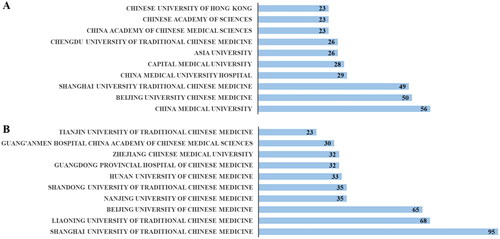
The VOSviewer software (V1.6.19) was used to visualize the 87 institutions in the English publications, and the CiteSpace software (V6.3.R1) was used to visualize the 122 institutions in the Chinese publications, with the minimum number of publications set at 3. illustrates that China Medical University, Beijing University of Traditional Chinese Medicine, Shanghai University of Traditional Chinese Medicine, and other institutions had more external collaborations in English articles. Moreover, illustrates that Beijing University of Chinese Medicine, Shanghai University of Traditional Chinese Medicine, and Guangdong Provincial Hospital of Chinese Medicine had more external collaborations in Chinese articles. For example, this present study, a collaborative effort between Tianjin University of Traditional Chinese Medicine and Tianjin Medical University, explored the research achievements of TCM-based research on breast cancer, lung cancer, hepatic carcinoma, colorectal cancer, gastric cancer, and other cancers in the past 5 years. Indeed, this study summarizes the direction of development of TCM-based research on cancer metastasis and offers prospects for future research (Wang et al. Citation2021). Another example, Beijing University of Chinese Medicine and China Academy of Chinese Medical Sciences collaborated to introduce the molecular mechanism of Chaihu Shugan powder in treating breast cancer by the network pharmacology (Xiao et al. Citation2020).
Author analysis
The VOSviewer software (V1.6.19) was used to create a co-occurrence density view of the main authors, which directly reflected the frequency density of co-occurrence among research objects. The analysis of publications resulted in the construction of a collaborative network based on authors with at least three publications. shows that the network included a total of 123 core authors in the English publications, with the names ‘Liu Sheng’, ‘Wang Wei’, and ‘Zhang Yi’ having the largest nodes, indicating that they published the most papers. shows that the network included a total of 234 core authors in the Chinese publications, with the names ‘Liu Sheng’, ‘Yin Dongfeng’, and ‘Liu Xiaofei’ having the largest nodes. The research content has been relatively concentrated, and frequent publications have been observed from many authors. The author distribution shows the characteristics of high-yield authors associated closely with other authors. Among them, ‘Liu Sheng’ from Shanghai University of Traditional Chinese Medicine was devoted to research in this field and published several articles in both English and Chinese. The paper entitled ‘Clinical study on postoperative triple-negative breast cancer with Chinese medicine Study protocol for an observational cohort trial’ was published and designed to evaluate the clinical effects of TCM syndrome classification on recurrence and metastasis rates, survival, and the quality of life in patients with triple-negative breast cancer (TNBC). This was the first clinical trial to evaluate progression-free survival and overall survival of TNBC patients receiving TCM treatment, which may be used to assess the feasibility of future larger clinical trials and to develop standardized TCM treatment protocols (Chen et al. Citation2018). Furthermore, Liu Sheng’s team investigated the antibone-metastasis activities and mechanisms of Wensheng Zhuanggu Fang (WSZG) extract, a traditional Chinese prescription, by evaluating the effect of this formula on the cross-dialogue between bone marrow mesenchymal stem cells (BMSCs) and breast cancer cells to trigger epithelial mesenchymal transformation (EMT) in vivo and in vitro. They found that WSZG treatment significantly inhibited motility, invasion, EMT-related genes and protein markers in BMSC-conditioned breast cancer cells (Ma et al. Citation2020).
Keyword co-occurrence
The VOSviewer software (V1.6.19) was used to construct a network of keyword co-occurrence for the included publications, and high-frequency keywords were screened. A total of 109 English keywords and 108 Chinese keywords out of the 4939 and 4899 keywords, respectively, were included in the analysis according to the inclusion criteria of >15 co-occurrences. In the keyword co-occurrence network, the larger nodes indicate a higher frequency of keyword occurrence and are more reflective of the current research hotspots in this field. shows that the English literature on the prevention and treatment of breast cancer with TCM can be classified into three categories: oncology (red), TCM prevention and treatment (green), and mechanism pathway (blue). The top five keywords in the English publications were ‘apoptosis’, ‘expression’, ‘in vitro’, ‘growth’ and ‘proliferation’, ‘growth’ and ‘proliferation’ after excluding the words in the retrieval formula, i.e., ‘breast cancer’ and ‘traditional Chinese medicine’. shows that the Chinese literature on the prevention and treatment of breast cancer with TCM can be classified into the clinical treatment (green), traditional Chinese medicine research (blue), and oncology (purple). The top five keywords in the Chinese publications were ‘chemotherapy’, ‘review’, ‘breast tumor’, ‘triple-negative breast cancer’, and ‘lymphedema’. These results showed that the in vitro experimental studies were common in most of the English publications, whereas broader concepts such as clinical features, pathogenesis, pharmacology and others were assessed in Chinese articles.
A timeline diagram can clearly show the timeframe covered by each research hotspot and reveal the connection between different research hotspots, thereby demonstrating changes in the research hotspots of TCM for breast cancer over the past 20 years as well as uncovering future research trends. shows the cluster of the keywords in conjunction with the time from 2003 to 2022, with 5-year blocks as individual time zones. Based on the keyword co-occurrence network, the log-likelihood ratio algorithm was applied to obtain the clustering module value (Q) > 0.3, which indicated that the clustering was effective, and the clustering contourness index (S) > 0.7, which indicated that the results of the cluster analysis were credible. For English and Chinese publications, Q = 0.4141 and 0.4216, and S = 0.7118 and 0.7605, respectively, indicating that the clustering was meaningful and the results were credible. Meanwhile, the keyword timeline graphs were further analyzed. The clustering of English and Chinese publications yielded six tags, respectively. Among them, network pharmacology (#1) was grouped into a separate category and ‘EMT’ was appeared in anticancer potential (#4) in English publications (). In Chinese publications (), ‘network pharmacology’ was appeared in traditional Chinese medicine (#0) and traditional Chinese medicine were applied in the stages of postoperative breast cancer (#2).
Keywords with citation bursts
The top 18 keywords with citation bursts in the English and Chinese publications, identified using CiteSpace (V6.3.R1), are respectively shown in . The blue line indicates the time interval, whereas the red line indicates the period when a burst occurred for a keyword (Chen et al. Citation2014). The former indicated that the phrase ‘alternative medicine’ was the longest-emerging keyword, appearing from 2004 to 2012, with an outbreak intensity of 3.95. The phrase ‘breast cancer cell’, ‘epithelial mesenchymal transition’ and ‘network pharmacology’ emerged as the strong keywords, with a burst intensity of 8.86, 8.74 and 8.64 in 2009, 2019 and 2020, respectively. The latter showed that ‘cell proliferation’ was the longest-emerging keyword, appearing from 2007 to 2014, with an outbreak intensity of 2.71. The phrase ‘network pharmacology’ was the strongest keyword, appearing in 2020, with an outbreak intensity of 12.69.
Discussion
General information
In recent years, there has been a growing body of research on the TCM-based treatment of breast cancer. TCM has shown positive outcomes in the treatment of breast cancer and in alleviating the adverse effects of radiotherapy and chemotherapy (Feng et al. Citation2023). This study provides valuable ideas and establishes a theoretical basis for the treatment of breast cancer using TCM. This indicates that TCM-based breast cancer treatment has received considerable attention both domestically and internationally, and the number of publications is expected to continue to increase in the future. China published the highest number of articles in the field of TCM-based prevention and treatment of breast cancer. Moreover, China ranked first in the total number of citations and H-index, suggesting that China is ahead of other countries in the field of TCM-based prevention and treatment of breast cancer both in terms of quantity and quality. It can be observed from the analysis of the co-authorship of all articles that the link strength of the Chinese co-authorship was the highest among the analyzed countries, indicating that China had extensive cooperation with other countries. These finding suggest that China has the strongest scientific research strength in the field of TCM-based prevention and treatment of breast cancer. As the country with the largest number of publications, China may be benefit by its extensive historical background, abundant Chinese medicine resources, unique theoretical system, extensive clinical experience, and robust support for scientific research. These factors have probably driven the development of TCM for breast cancer treatment, thereby providing an effective treatment option for patients.
Keyword burst analysis showed that the prominent terms in the field of TCM-based treatment of breast cancer in the past 5 years included survival, network pharmacology, quercetin, epithelial mesenchymal transition, nursing, and adverse reactions. Among these, ‘epithelial mesenchymal transition’ and the ‘network pharmacology’ emerged with high intensity and will continue to remain an important topic of research until 2022. The word ‘epithelial mesenchymal transition’ was examined as a keyword in the European Journal of Pharmacology (Lu et al. Citation2021) and Experimental and Therapeutic Medicine (Ren et al. Citation2020). Additionally, the term ‘network pharmacology’ has been studied as a keyword in publications (Guo et al. Citation2022; Li et al. Citation2022) and burst onto the scene in 2020 in both English and Chinese publications owing to multiple reasons. By analyzing the causes, the impediments associated with experimental studies may represent a significant factor resulting in the rapid growth of network pharmacology. Many traditional experimental studies have been limited and hindered due to COVID-19, resulting in researchers exploring new ways to continue their research work. In this context, the use of public databases for mining research has become a popular choice.
Hotspots
The co-occurrence analysis of keywords and the citation bursts of keywords revealed that studies on the TCM-based treatment of breast cancer mainly focused on epithelial mesenchymal transition (EMT) and network pharmacology.
EMT is a key process in cancer cell metastasis, characterized by a reduced adhesion of cancer cells to adjacent cells and increased cell motility and migration ability (Dochi et al. Citation2023). Studies have confirmed that EMT is closely related to breast cancer invasion and metastasis (Huber et al. Citation2004; Pires et al. Citation2017; Dai et al. Citation2021; Camp et al. Citation2022). This association might promote the infiltration of breast cancer cells into the surrounding organs and tissues, the ability to move to and invade distant tissues, and even escape the immune system. Studies were reported that the solute carrier family 38member 3 (SLC38A3), a novel therapeutic target, is overexpressed in breast cancer and promotes breast cancer metastasis via the GSK3 beta/beta-catenin/EMT pathway (Tan et al. Citation2024). And, the experimental results, that Sorbin and SH3 domain-containing protein 1 (SORBS1, CAP/ponsin) could inhibit the invasion and migration of breast cancer cells, induce macrophage M1-type polarization, and block EMT of breast cancer cells, were verified, and it indicated that the PI3K/AKT signaling pathway was regulated (Feng et al. Citation2024). Many Chinese herb extracts, such as fucose, resveratrol, emodin, and ginkgolic acid can inhibit the occurrence of EMT through different pathways, thus playing a role in inhibiting the growth and metastasis of breast cancer cells (Wu et al. Citation2023). Therefore, it has received increased attention in tumor research and has become an important research direction and hotspot in the treatment of breast cancer.
The promotion of invasion and movement of tumor cells by altering cell-cell and cell-matrix interactions is a hallmark of EMT, as shown in . For example, in lung cancer cells, TGF-β1 acts on the JNK/p38/PI3K pathway to suppress NM-II expression, thereby promoting the EMT process and lung cancer invasion and metastasis (Tan et al. Citation2017). It has also been shown that PDGF-BB promotes the EMT process and invasive metastasis of lung cancer cells by upregulating the expression of MCP-1 in human A549 lung cancer cells (Neri et al. Citation2017). Similarly, in cholangiocarcinoma, TGF-β induces increased the expression of N-cadherin (N-cad) and decreased the expression of E-cadherin (E-cad), thereby activating EMT and enhancing the invasiveness of cholangiocarcinoma cells (Deng et al. Citation2023). Further insights into the modulation of EMT have revealed specific molecular mechanisms in various cancer types. For example, miR-186 inhibited Twist1, N-cad, and waveform protein expression but increased E-cad expression, which in turn affected the EMT process (Zhang et al. Citation2019). In gastric cancer, it was shown that miR-30c-5p inhibited the metastasis of gastric cancer cells by suppressing the expression of metastatic MTA1 and inhibiting EMT (Cao et al. Citation2017). In addition, HGF upregulates the expression of the transcription factor Snail, potentially promoting EMT in gastric cancer cells (Toiyama et al. Citation2012). In hepatocellular carcinoma cells, Snail has been implicated in increasing the invasive metastatic capacity of tumors via the inhibition of E-cad, while promoting the expression of matrix metalloproteinase (Zhou et al. Citation2011). The inhibition of HOXB7 expression was reported to result in the increased expression of E-cad and decreased expression of N-cad, waveform proteins, and matrix metalloproteins in HCC-LM3 liver cancer cells. Thus, the inhibition of the EMT process leads to an inhibitory effect on cancer cells (Zhuang et al. Citation2023).
Network pharmacology
The emergence of the phrase ‘network pharmacology’ in Chinese publications is consistent with the ‘holistic view’ of TCM theory, characterized by the ‘multi-component-multi-target-multi-channel’ network construction idea. This idea has become a popular tool for studying the pharmacological basis of TCM and the mechanism of disease intervention, which plays an important role in the TCM modernization process (Nogales et al. Citation2022). Therefore, network pharmacology has received extensive attention from scholars in recent years. However, the number of articles related to online pharmacology has increased slowly since 2023, with many incorporating experimental validation.
The continuous development of computer science and artificial intelligence technology has led to the advancement of data analysis methods and machine learning algorithms. These advancements provide powerful technical support for the development of network pharmacology tools. Researchers can now process and analyze large amounts of data more effectively, discover more precise patterns and relationships, and gain a better understanding of the mechanisms of action and effects of drugs. Thus, the rise of network pharmacology is a result of both the obstruction of experimental research and technological progress. It has provided new research tools and methods to understand the mechanism of action and effects of drugs more effectively and resulted in several possibilities for drug development in the future.
The study of TCM for breast cancer treatment has attracted considerable attention from researchers. The diverse range of active ingredients in TCM and the interactions among these ingredients are yet to be explored. Hence, there is considerable potential for the development of TCM-based treatments for breast cancer. Recently, the article titled ‘Network pharmacology study on the underlying mechanism of Danggui-Kushen Herb Pair in adjuvant chemotherapeutics against breast cancer’ was published by Zhejiang Academy of Traditional Chinese Medicine (Hu et al. Citation2024). This study indicated that hyperforin, kushenin, kushenol T, and other active compounds in Danggui-Kushen Herb Pair could regulate AKT1, TP53, CASP3, and other signaling pathways. The classic prescription, Danggui-Kushen Herb Pair, plays the preventive and therapeutic roles in breast cancer.
Limitations and suggestions
The indicators involved in bibliometrics are affected by the length of the publication period. Recently published literature may show a lower numerical value in various indicators owing to the short publication time, which may cause deviation in the results. The trend of breast cancer incidence and the application of TCM in the prevention and treatment of breast cancer are not static. Thus, to grasp the development trend of this field more accurately, it is necessary to closely track its dynamics in the future.
Conclusions
The treatment of breast cancer using TCM has significant research value and promising application prospects. This is attributable to its extensive historic use and clinical significance as well as to the concepts of TCM-based breast cancer treatment being in alignment with the modern medical pursuit of the treatment of malignant tumors. There is a high degree of interest in the treatment of breast cancer with TCM both domestically and internationally. However, cooperation among countries and internationally based institutions is somewhat limited, which hinders the optimal development of this field of research. Extensive cooperation and exchanges among countries and their institutions are necessary to promote the development of TCM-based breast cancer treatment for curative or palliative purposes. A visual analysis of the research hotspots and trends in the TCM-based treatment of breast cancer found that EMT and network pharmacology are the areas of focus; these hotspots represent the trends of clinical research in the future. The development of modern science and technology and in-depth research has resulted in broader prospects for the research and application of TCM-based breast cancer treatment. This development is expected to yield more effective means and solutions for the treatment of not only breast cancer but also other malignant tumors.
Authors’ contributions
Y Jing and J Shi were responsible for the conception and design. J Yuan and Y Liu helped Y Jing and J Shi designed the study and developed the methodology. Tt Zhang and C Zheng were responsible for the data acquisition. X Ding and Cr Zhu normalized the pictures. J Yuan and Y Liu analyzed the data, interpreted the results, and edited the manuscript. Y Jing and J Shi were responsible for the writing, review, and revision of the manuscript. All authors read and approved the final manuscript.
Disclosure statement
No potential conflict of interest was reported by the author(s).
Additional information
Funding
References
- Bae SY, Kim S, Lee JH, Lee HC, Lee SK, Kil WH, Kim SW, Lee JE, Nam SJ. 2015. Poor prognosis of single hormone receptor-positive breast cancer: similar outcome as triple-negative breast cancer. BMC Cancer. 15(1):138. doi: 10.1186/s12885-015-1121-4.
- Camp FA, Brunetti TM, Williams MM, Christenson JL, Sreekanth V, Costello JC, Hay ZLZ, Kedl RM, Richer JK, Slansky JE. 2022. Antigens expressed by breast cancer cells undergoing EMT stimulate cytotoxic CD8+ T cell immunity. Cancers (Basel). 14(18):4397. doi: 10.3390/cancers14184397.
- Cao JM, Li GZ, Han M, Xu HL, Huang KM. 2017. MiR-30c-5p suppresses migration, invasion and epithelial to mesenchymal transition of gastric cancer via targeting MTA1. Biomed Pharmacother. 93:554–560. doi: 10.1016/j.biopha.2017.06.084.
- Chen KW, Chung KP, Hsu CH. 2023. The intention of utilization and experience toward traditional Chinese medicine among breast cancer patients in the early and late stages: a qualitative study. BMC Complement Med Ther. 23(1):226. doi: 10.1186/s12906-023-04054-0.
- Chen CM, Dubin R, Kim MC. 2014. Emerging trends and new developments in regenerative medicine: a scientometric update (2000 - 2014). Expert Opin Biol Ther. 14:1295–1317.
- Chen JJ, Qin YN, Sun CP, Hao W, Zhang S, Wang Y, Chen J, Chen LX, Ruan YY, Liu S. 2018. Clinical study on postoperative triple-negative breast cancer with Chinese medicine Study protocol for an observational cohort trial. Medicine (Baltimore). 97(25):e11061. doi: 10.1097/MD.0000000000011061.
- Cui Y, Shu XO, Gao YT, Wen WQ, Ruan ZX, Jin F, Zheng W. 2004. Use of complementary and alternative medicine by Chinese women with breast cancer. Breast Cancer Res Treat. 85(3):263–270. doi: 10.1023/B:BREA.0000025422.26148.8d.
- Dai XY, Xin YL, Xu WZ, Tian XX, Wei XF, Zhang HQ. 2021. CBP-mediated Slug acetylation stabilizes Slug and promotes EMT and migration of breast cancer cells. Sci China-Life Sci. 64:563–574.
- Deng LM, Bao WM, Zhang BF, Zhang SA, Chen ZY, Zhu XW, He BJ, Wu LJ, Chen XH, Deng T, et al. 2023. AZGP1 activation by lenvatinib suppresses intrahepatic cholangiocarcinoma epithelial-mesenchymal transition through the TGF-β1/Smad3 pathway. Cell Death Dis. 14(9):590. doi: 10.1038/s41419-023-06092-5.
- Ding X, Yang Z. 2022. Knowledge mapping of platform research: a visual analysis using VOSviewer and CiteSpace. Electron Commer Res. 22(3):787–809. doi: 10.1007/s10660-020-09410-7.
- Dochi H, Kondo S, Komura S, Moriyama-Kita M, Komori T, Nanbo A, Sakaguchi M, Fukuyo M, Hamabe-Horiike T, Tanaka M, et al. 2023. Peritumoral SPARC expression induced by exosomes from nasopharyngeal carcinoma infected Epstein-Barr virus: a poor prognostic marker. Int J Cancer. 154:895–911.
- Dora M, Kumar HA. 2017. An empirical analysis of the research trends in the field of library and information science in India -2004-2015. Collnet J Scientometr Inf Manag. 11(2):361–378.
- Feng K, Di Y, Han M, Yan WT, Wang YM. 2024. SORBS1 inhibits epithelial to mesenchymal transition (EMT) of breast cancer cells by regulating PI3K/AKT signaling and macrophage phenotypic polarization. Aging (Albany NY). 16(5):4789–4810. doi: 10.18632/aging.205632.
- Feng RQ, Li DH, Liu XK, Zhao XH, Wen QE, Yang Y. 2023. Traditional Chinese medicine for breast cancer: a review. Breast Cancer-Targets Ther. 15:747–759.
- Greenwalt I, Zaza N, Das S, Li BD. 2020. Precision medicine and targeted therapies in breast cancer. Surg Oncol Clin N Am. 29(1):51–62.
- Guo Q, Pei XH, Chu AJ, Guo YB, Fan YY, Wang CH, Zhang SJ, Sun SQ, Liu YF, Wang X. 2022. The mechanism of action of Fangji Huangqi Decoction on epithelial-mesenchymal transition in breast cancer using high-throughput next-generation sequencing and network pharmacology. J Ethnopharmacol. 284:114793. doi: 10.1016/j.jep.2021.114793.
- Huber MA, Azoitei N, Baumann B, Grünert S, Sommer A, Pehamberger H, Kraut N, Beug H, Wirth T. 2004. NF-κB is essential for epithelial-mesenchymal transition and metastasis in a model of breast cancer progression. J Clin Invest. 114:569–581.
- Hu YJ, He JL, Xu YL. 2024. Network pharmacology study on the underlying mechanism of Danggui-Kushen herb pair in adjuvant chemotherapeutics against breast cancer. Comb Chem High Throughput Screen. 27:1–12.
- Hu J, Zhang HN, Feng S, Ha YX, Wei CY, Wang XJ, Zhang R, Li B. 2021. Randomized controlled trials of Chinese herbal medicine published in English from 2010 to 2019: a bibliometrics study. Ann Pallliat Med. 10:12945–12954.
- Lei SY, Zheng RS, Zhang SW, Wang SM, Chen R, Sun KX, Zeng HM, Zhou JC, Wei WQ. 2021. Global patterns of breast cancer incidence and mortality: a population-based cancer registry data analysis from 2000 to 2020. Cancer Commun. 41:1183–1194.
- Li FF, Shi YY, Zhang Y, Yang XJ, Wang Y, Jiang KX, Hua CY, Wu CY, Sun CP, Qin YN, et al. 2022. Investigating the mechanism of Xian-ling-lian-xia-fang for inhibiting vasculogenic mimicry in triple negative breast cancer via blocking VEGF/MMPs pathway. Chin Med. 17(1):44. doi: 10.1186/s13020-022-00597-5.
- Liu JN, Zhai X, Liao XF. 2020. Bibliometric analysis on cardiovascular disease treated by traditional Chinese medicines based on big data. Int J Parallel Emerg Distrib Syst. 35:323–339.
- Lu YR, Ding Y, Wei JH, He S, Liu XM, Pan HH, Yuan B, Liu Q, Zhang JB. 2021. Anticancer effects of traditional Chinese medicine on epithelial-mesenchymal transition (EMT) in breast cancer: cellular and molecular targets. Eur J Pharmacol. 907:174275. doi: 10.1016/j.ejphar.2021.174275.
- Luo H, Vong CT, Chen HB, Gao Y, Lyu P, Qiu L, Zhao MM, Liu Q, Cheng ZH, Zou J, et al. 2019. Naturally occurring anti-cancer compounds: shining from Chinese herbal medicine. Chin Med. 14(1):48. doi: 10.1186/s13020-019-0270-9.
- Lyu P, Liu XL, Yao T. 2023. A bibliometric analysis of literature on bibliometrics in recent half-century. J Inf Sci. 49(4):1–21.
- Ma J, Li JJ, Wang Y, Chen WL, Zheng PY, Chen YA, Sun ZP, Liu J, Zhou Y, Wang JY, et al. 2020. WSZG inhibits BMSC-induced EMT and bone metastasis in breast cancer by regulating TGF-β1/Smads signaling. Biomed Pharmacother. 121:16.
- Neri S, Miyashita T, Hashimoto H, Suda Y, Ishibashi M, Kii H, Watanabe H, Kuwata T, Tsuboi M, Goto K, et al. 2017. Fibroblast-led cancer cell invasion is activated by epithelial mesenchymal transition through platelet-derived growth factor BB secretion of lung adenocarcinoma. Cancer Lett. 395:20–30.
- Niazi MA. 2016. CiteSpace: a practical guide for mapping scientific literature. Compex Adapt Syst Model. 4:23.
- Nogales C, Mamdouh ZM, List M, Kiel C, Casas AI, Schmidt H. 2022. Network pharmacology: curing causal mechanisms instead of treating symptoms. Trends Pharmacol Sci. 43(2):136–150. doi: 10.1016/j.tips.2021.11.004.
- Perianes-Rodriguez A, Waltman L, van Eck NJ. 2016. Constructing bibliometric networks: a comparison between full and fractional counting. J Informetr. 10:1178–1195.
- Pires BRB, Mencalha AL, Ferreira GM, de Souza WF, Morgado-Díaz JA, Maia AM, Corrêa S, Abdelhay E. 2017. NF-kappaB is involved in the regulation of EMT genes in breast cancer cells. PLoS One. 12(1):e0169622. doi: 10.1371/journal.pone.0169622.
- Qi FH, Zhao L, Zhou AY, Zhang B, Li AY, Wang ZX, Han JQ. 2015. The advantages of using traditional Chinese medicine as an adjunctive therapy in the whole course of cancer treatment instead of only terminal stage of cancer. BioSci Trends. 9(1):16–34.
- Qian C, Liang Y, Yang M, Bao SN, Bai JL, Yin YM, Yu H. 2021. Effect of breast-conserving surgery plus radiotherapy versus mastectomy on breast cancer-specific survival for early-stage contralateral breast cancer. Gland Surg. 10(10):2978–2996. doi: 10.21037/gs-21-413.
- Ren LL, Mo WJ, Wang LL, Wang XJ. 2020. Matrine suppresses breast cancer metastasis by targeting ITGB1 and inhibiting epithelial-to-mesenchymal transition. Exp Ther Med. 19(1):367–374.
- Salerno C, Vento AR, Giacchino M, Lissidini G, Galimberti V, Corso G. 2018. Intra-operative radiotherapy management for breast cancer treatment in patients with pseudoxanthoma elasticum: a case report. Breast J. 24(3):385–387. doi: 10.1111/tbj.12944.
- Shin HJ, Hwang KA, Choi KC. 2019. Antitumor effect of various phytochemicals on diverse types of thyroid cancers. Nutrients. 11(1):125. doi: 10.3390/nu11010125.
- Sung H, Ferlay J, Siegel RL, Laversanne M, Soerjomataram I, Jemal A, Bray F. 2021. Global cancer statistics 2020: GLOBOCAN estimates of incidence and mortality worldwide for 36 cancers in 185 countries. CA Cancer J Clin. 71(3):209–249. doi: 10.3322/caac.21660.
- Tada H, Gonda K, Kitamura N, Ishida T. 2023. Clinical significance of ABCG2/BCRP quantified by fluorescent nanoparticles in breast cancer patients undergoing neoadjuvant chemotherapy. Cancers (Basel). 15(8):2365. doi: 10.3390/cancers15082365.
- Tan ZQ, Boyapati K, Tressler CM, Jenkinson NM, Glunde K. 2024. Glutamine transporter SLC38A3 promotes breast cancer metastasis via Gsk3β/β-catenin/EMT pathway. Cancer Lett. 586:216653.
- Tan WJ, Tan QY, Wang T, Lian M, Zhang L, Cheng ZS. 2017. Calpain 1 regulates TGF-β1-induced epithelial-mesenchymal transition in human lung epithelial cells via PI3K/Akt signaling pathway. Am J Transl Res. 9:1402–1409.
- Toiyama Y, Yasuda H, Saigusa S, Matushita K, Fujikawa H, Tanaka K, Mohri Y, Inoue Y, Goel A, Kusunoki M. 2012. Co-expression of hepatocyte growth factor and c-Met predicts peritoneal dissemination established by autocrine hepatocyte growth factor/c-Met signaling in gastric cancer. Int J Cancer. 130(12):2912–2921. doi: 10.1002/ijc.26330.
- Waks L, Kramer EO. 2023. Bibliometrics and qualitative assessment: a pragmatist approach. Contemp Pragmat. 20(1-2):150–168.
- Waltman L, Van Eck NJ. 2013. A smart local moving algorithm for large-scale modularity-based community detection. Eur Phys J B. 86(11):471. doi: 10.1140/epjb/e2013-40829-0.
- Wang KL, Chen Q, Shao YY, Yin SS, Liu CY, Liu YM, Wang R, Wang T, Qiu YL, Yu HY. 2021. Anticancer activities of TCM and their active components against tumor metastasis. Biomed Pharmacother. 133:111044.
- Wang SH, Qin J, Meng XL, Zhang Y. 2022. Research hotspots and trends in Chinese minority traditional medicine during 2021: a visual bibliometrics analysis. Tradit Med Res. 7(3):29. doi: 10.53388/TMR20220317271.
- Wu J, Wang J, Su Q, Ding W, Li T, Yu JX, Cao BW. 2018. Traditional Chinese medicine Astragalus polysaccharide enhanced antitumor effects of the angiogenesis inhibitor apatinib in pancreatic cancer cells on proliferation, invasiveness, and apoptosis. OncoTargets Ther. 11:2685–2698.
- Wu SH, Yan MX, Liu JY, Li YZ, Tian RM, Li C, Huang LH, Lu ZS, Xu P, Mao W. 2023. Clerodendranthus spicatus inhibits epithelial-mesenchymal transition of renal tubular cells through the NF-κB/Snail signalling pathway in hyperuricaemia nephropathy. Pharm Biol. 61:1274–1285.
- Xiang YN, Cuo ZM, Zhu PF, Chen J, Huang YY. 2019. Traditional Chinese medicine as a cancer treatment: modern perspectives of ancient but advanced science. Cancer Med. 8:1958–1975.
- Xiao KM, Li KX, Long SD, Kong CF, Zhu SJ. 2020. Potential molecular mechanisms of Chaihu-Shugan-San in treatment of breast cancer based on network pharmacology. Evid-Based Complement Altern Med. 2020:9.
- Xie XX, Xiong GY, Chen WJ, Fu HD, Li MQ, Cui XY. 2020. FOXD3 inhibits cell proliferation, migration, and invasion in nasopharyngeal carcinoma through regulation of the PI3K Akt pathway. Biochem Cell Biol. 98:653–660.
- Zhang M, Shi BC, Zhang K. 2019. miR-186 Suppresses the progression of cholangiocarcinoma cells through inhibition of Twist1. Oncol Res. 27(9):1061–1068. doi: 10.3727/096504019X15565325878380.
- Zhou WJ, Geng ZH, Chi S, Zhang WL, Niu XF, Lan SJ, Ma L, Yang XS, Wang LJ, Ding YQ, et al. 2011. Slit-Robo signaling induces malignant transformation through Hakai-mediated E-cadherin degradation during colorectal epithelial cell carcinogenesis. Cell Res. 21(4):609–626. doi: 10.1038/cr.2011.17.
- Zhu X, Wang K, Zhang K, Huang BA, Zhang J, Zhang Y, Zhu L, Zhou B, Zhou FF. 2013. Ziyuglycoside II inhibits the growth of human breast carcinoma MDA-MB-435 cells via cell cycle arrest and induction of apoptosis through the mitochondria dependent pathway. Int J Mol Sci. 14:18041–18055.
- Zhuang PY, Wang D, Zhang KW, Wang JD, Shen J. 2023. Sorafenib promotes hepatocellular carcinoma invasion via interleukin-6/HIF-1α/PFKFB3. J Cancer. 14:1859–1874.

